Will the Australian economy benefit from President Trump's protectionist policies?
VerifiedAdded on 2023/05/28
|7
|1823
|290
AI Summary
This article analyzes the impact of President Trump's protectionist policies on the Australian economy. It discusses how Australia's exports and agricultural sector are benefiting from the trade war between the US and China. The article also highlights the major products traded by Australia and its major trading partners.
Contribute Materials
Your contribution can guide someone’s learning journey. Share your
documents today.
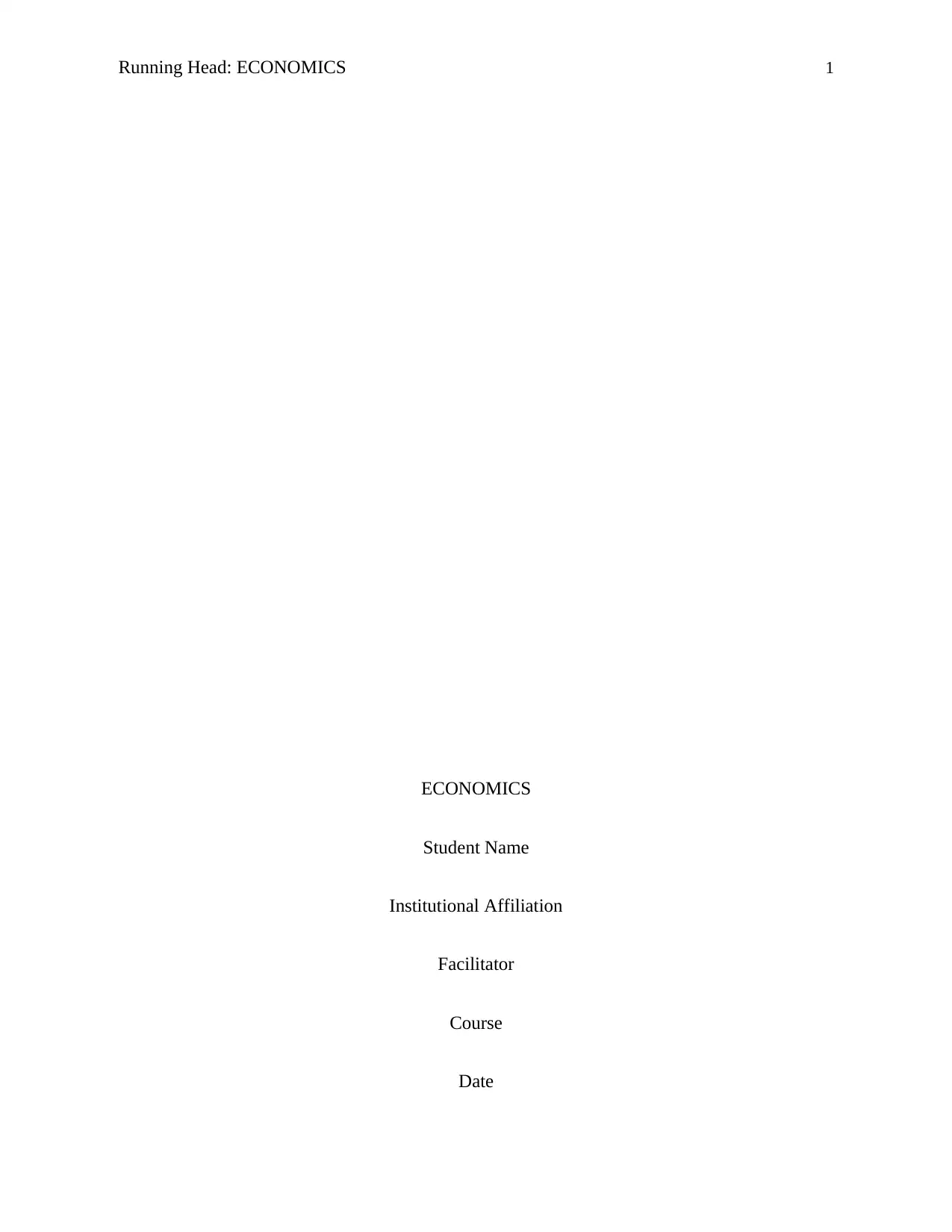
Running Head: ECONOMICS 1
ECONOMICS
Student Name
Institutional Affiliation
Facilitator
Course
Date
ECONOMICS
Student Name
Institutional Affiliation
Facilitator
Course
Date
Secure Best Marks with AI Grader
Need help grading? Try our AI Grader for instant feedback on your assignments.
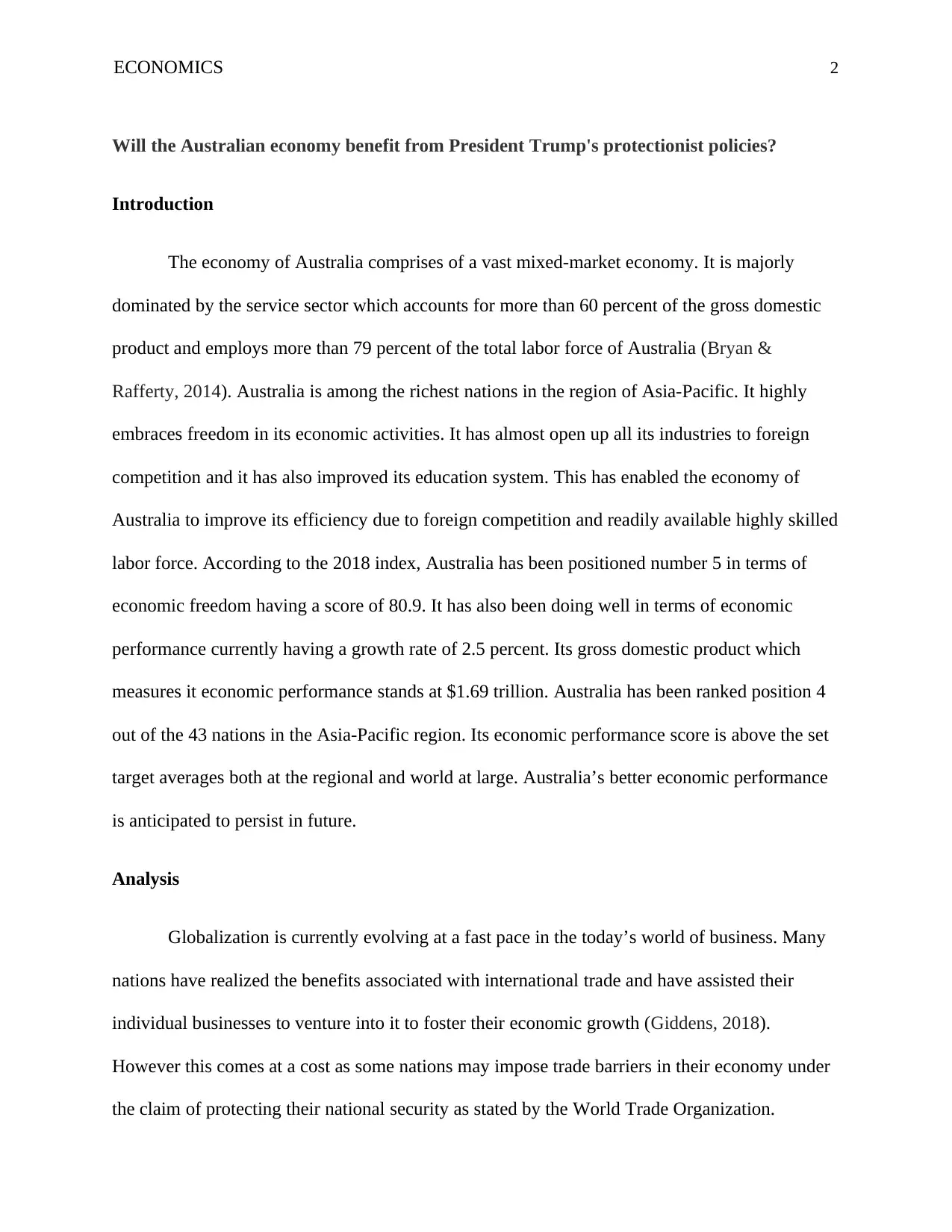
ECONOMICS 2
Will the Australian economy benefit from President Trump's protectionist policies?
Introduction
The economy of Australia comprises of a vast mixed-market economy. It is majorly
dominated by the service sector which accounts for more than 60 percent of the gross domestic
product and employs more than 79 percent of the total labor force of Australia (Bryan &
Rafferty, 2014). Australia is among the richest nations in the region of Asia-Pacific. It highly
embraces freedom in its economic activities. It has almost open up all its industries to foreign
competition and it has also improved its education system. This has enabled the economy of
Australia to improve its efficiency due to foreign competition and readily available highly skilled
labor force. According to the 2018 index, Australia has been positioned number 5 in terms of
economic freedom having a score of 80.9. It has also been doing well in terms of economic
performance currently having a growth rate of 2.5 percent. Its gross domestic product which
measures it economic performance stands at $1.69 trillion. Australia has been ranked position 4
out of the 43 nations in the Asia-Pacific region. Its economic performance score is above the set
target averages both at the regional and world at large. Australia’s better economic performance
is anticipated to persist in future.
Analysis
Globalization is currently evolving at a fast pace in the today’s world of business. Many
nations have realized the benefits associated with international trade and have assisted their
individual businesses to venture into it to foster their economic growth (Giddens, 2018).
However this comes at a cost as some nations may impose trade barriers in their economy under
the claim of protecting their national security as stated by the World Trade Organization.
Will the Australian economy benefit from President Trump's protectionist policies?
Introduction
The economy of Australia comprises of a vast mixed-market economy. It is majorly
dominated by the service sector which accounts for more than 60 percent of the gross domestic
product and employs more than 79 percent of the total labor force of Australia (Bryan &
Rafferty, 2014). Australia is among the richest nations in the region of Asia-Pacific. It highly
embraces freedom in its economic activities. It has almost open up all its industries to foreign
competition and it has also improved its education system. This has enabled the economy of
Australia to improve its efficiency due to foreign competition and readily available highly skilled
labor force. According to the 2018 index, Australia has been positioned number 5 in terms of
economic freedom having a score of 80.9. It has also been doing well in terms of economic
performance currently having a growth rate of 2.5 percent. Its gross domestic product which
measures it economic performance stands at $1.69 trillion. Australia has been ranked position 4
out of the 43 nations in the Asia-Pacific region. Its economic performance score is above the set
target averages both at the regional and world at large. Australia’s better economic performance
is anticipated to persist in future.
Analysis
Globalization is currently evolving at a fast pace in the today’s world of business. Many
nations have realized the benefits associated with international trade and have assisted their
individual businesses to venture into it to foster their economic growth (Giddens, 2018).
However this comes at a cost as some nations may impose trade barriers in their economy under
the claim of protecting their national security as stated by the World Trade Organization.
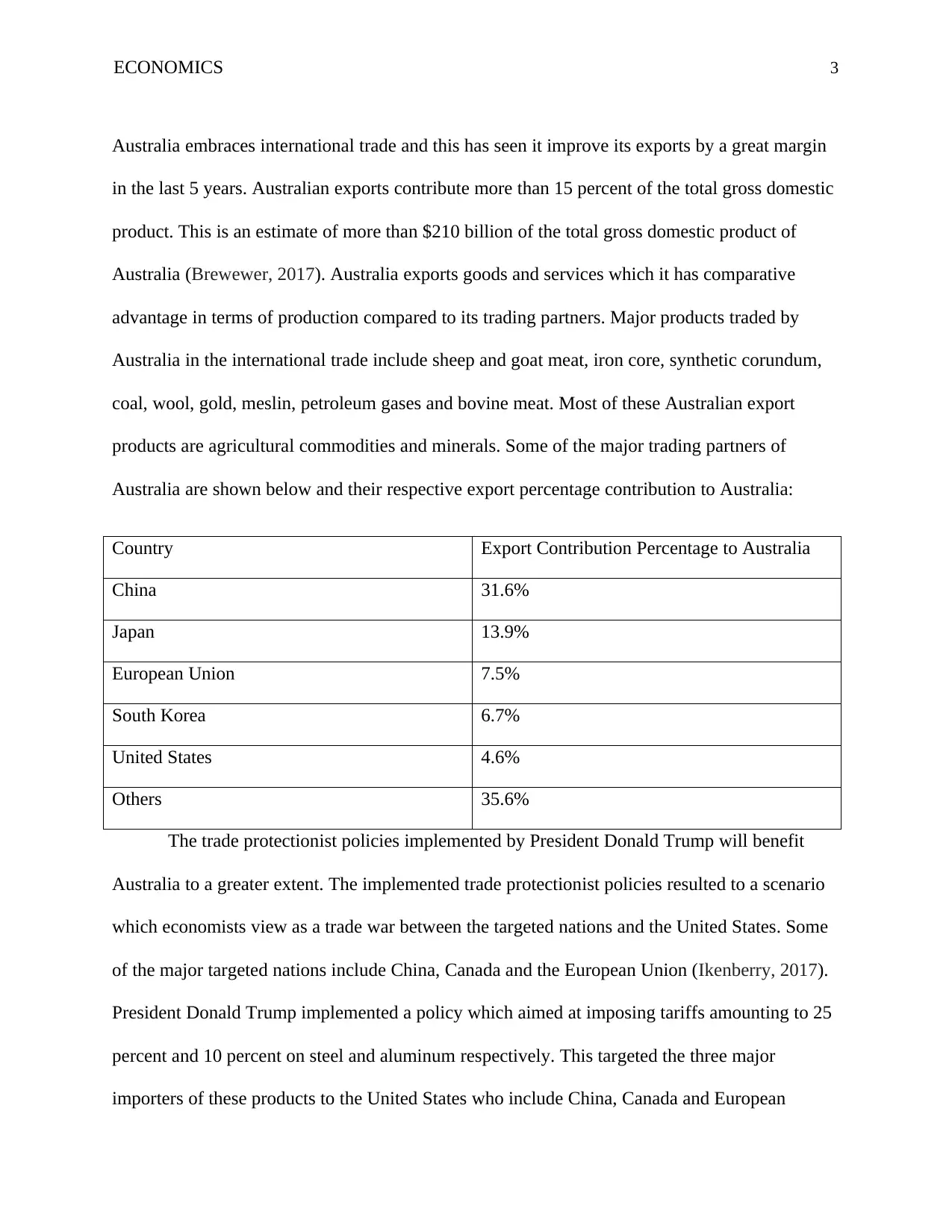
ECONOMICS 3
Australia embraces international trade and this has seen it improve its exports by a great margin
in the last 5 years. Australian exports contribute more than 15 percent of the total gross domestic
product. This is an estimate of more than $210 billion of the total gross domestic product of
Australia (Brewewer, 2017). Australia exports goods and services which it has comparative
advantage in terms of production compared to its trading partners. Major products traded by
Australia in the international trade include sheep and goat meat, iron core, synthetic corundum,
coal, wool, gold, meslin, petroleum gases and bovine meat. Most of these Australian export
products are agricultural commodities and minerals. Some of the major trading partners of
Australia are shown below and their respective export percentage contribution to Australia:
Country Export Contribution Percentage to Australia
China 31.6%
Japan 13.9%
European Union 7.5%
South Korea 6.7%
United States 4.6%
Others 35.6%
The trade protectionist policies implemented by President Donald Trump will benefit
Australia to a greater extent. The implemented trade protectionist policies resulted to a scenario
which economists view as a trade war between the targeted nations and the United States. Some
of the major targeted nations include China, Canada and the European Union (Ikenberry, 2017).
President Donald Trump implemented a policy which aimed at imposing tariffs amounting to 25
percent and 10 percent on steel and aluminum respectively. This targeted the three major
importers of these products to the United States who include China, Canada and European
Australia embraces international trade and this has seen it improve its exports by a great margin
in the last 5 years. Australian exports contribute more than 15 percent of the total gross domestic
product. This is an estimate of more than $210 billion of the total gross domestic product of
Australia (Brewewer, 2017). Australia exports goods and services which it has comparative
advantage in terms of production compared to its trading partners. Major products traded by
Australia in the international trade include sheep and goat meat, iron core, synthetic corundum,
coal, wool, gold, meslin, petroleum gases and bovine meat. Most of these Australian export
products are agricultural commodities and minerals. Some of the major trading partners of
Australia are shown below and their respective export percentage contribution to Australia:
Country Export Contribution Percentage to Australia
China 31.6%
Japan 13.9%
European Union 7.5%
South Korea 6.7%
United States 4.6%
Others 35.6%
The trade protectionist policies implemented by President Donald Trump will benefit
Australia to a greater extent. The implemented trade protectionist policies resulted to a scenario
which economists view as a trade war between the targeted nations and the United States. Some
of the major targeted nations include China, Canada and the European Union (Ikenberry, 2017).
President Donald Trump implemented a policy which aimed at imposing tariffs amounting to 25
percent and 10 percent on steel and aluminum respectively. This targeted the three major
importers of these products to the United States who include China, Canada and European
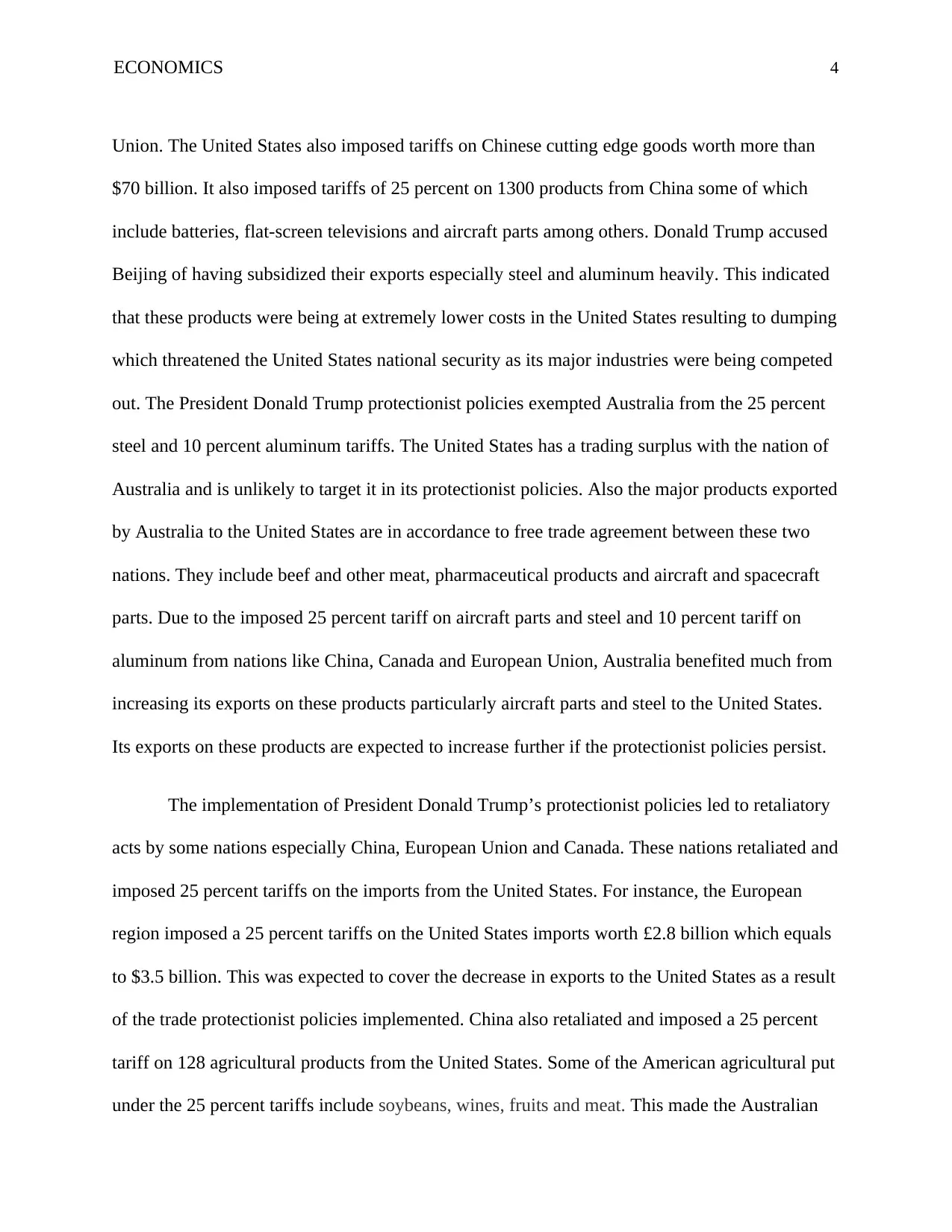
ECONOMICS 4
Union. The United States also imposed tariffs on Chinese cutting edge goods worth more than
$70 billion. It also imposed tariffs of 25 percent on 1300 products from China some of which
include batteries, flat-screen televisions and aircraft parts among others. Donald Trump accused
Beijing of having subsidized their exports especially steel and aluminum heavily. This indicated
that these products were being at extremely lower costs in the United States resulting to dumping
which threatened the United States national security as its major industries were being competed
out. The President Donald Trump protectionist policies exempted Australia from the 25 percent
steel and 10 percent aluminum tariffs. The United States has a trading surplus with the nation of
Australia and is unlikely to target it in its protectionist policies. Also the major products exported
by Australia to the United States are in accordance to free trade agreement between these two
nations. They include beef and other meat, pharmaceutical products and aircraft and spacecraft
parts. Due to the imposed 25 percent tariff on aircraft parts and steel and 10 percent tariff on
aluminum from nations like China, Canada and European Union, Australia benefited much from
increasing its exports on these products particularly aircraft parts and steel to the United States.
Its exports on these products are expected to increase further if the protectionist policies persist.
The implementation of President Donald Trump’s protectionist policies led to retaliatory
acts by some nations especially China, European Union and Canada. These nations retaliated and
imposed 25 percent tariffs on the imports from the United States. For instance, the European
region imposed a 25 percent tariffs on the United States imports worth £2.8 billion which equals
to $3.5 billion. This was expected to cover the decrease in exports to the United States as a result
of the trade protectionist policies implemented. China also retaliated and imposed a 25 percent
tariff on 128 agricultural products from the United States. Some of the American agricultural put
under the 25 percent tariffs include soybeans, wines, fruits and meat. This made the Australian
Union. The United States also imposed tariffs on Chinese cutting edge goods worth more than
$70 billion. It also imposed tariffs of 25 percent on 1300 products from China some of which
include batteries, flat-screen televisions and aircraft parts among others. Donald Trump accused
Beijing of having subsidized their exports especially steel and aluminum heavily. This indicated
that these products were being at extremely lower costs in the United States resulting to dumping
which threatened the United States national security as its major industries were being competed
out. The President Donald Trump protectionist policies exempted Australia from the 25 percent
steel and 10 percent aluminum tariffs. The United States has a trading surplus with the nation of
Australia and is unlikely to target it in its protectionist policies. Also the major products exported
by Australia to the United States are in accordance to free trade agreement between these two
nations. They include beef and other meat, pharmaceutical products and aircraft and spacecraft
parts. Due to the imposed 25 percent tariff on aircraft parts and steel and 10 percent tariff on
aluminum from nations like China, Canada and European Union, Australia benefited much from
increasing its exports on these products particularly aircraft parts and steel to the United States.
Its exports on these products are expected to increase further if the protectionist policies persist.
The implementation of President Donald Trump’s protectionist policies led to retaliatory
acts by some nations especially China, European Union and Canada. These nations retaliated and
imposed 25 percent tariffs on the imports from the United States. For instance, the European
region imposed a 25 percent tariffs on the United States imports worth £2.8 billion which equals
to $3.5 billion. This was expected to cover the decrease in exports to the United States as a result
of the trade protectionist policies implemented. China also retaliated and imposed a 25 percent
tariff on 128 agricultural products from the United States. Some of the American agricultural put
under the 25 percent tariffs include soybeans, wines, fruits and meat. This made the Australian
Secure Best Marks with AI Grader
Need help grading? Try our AI Grader for instant feedback on your assignments.
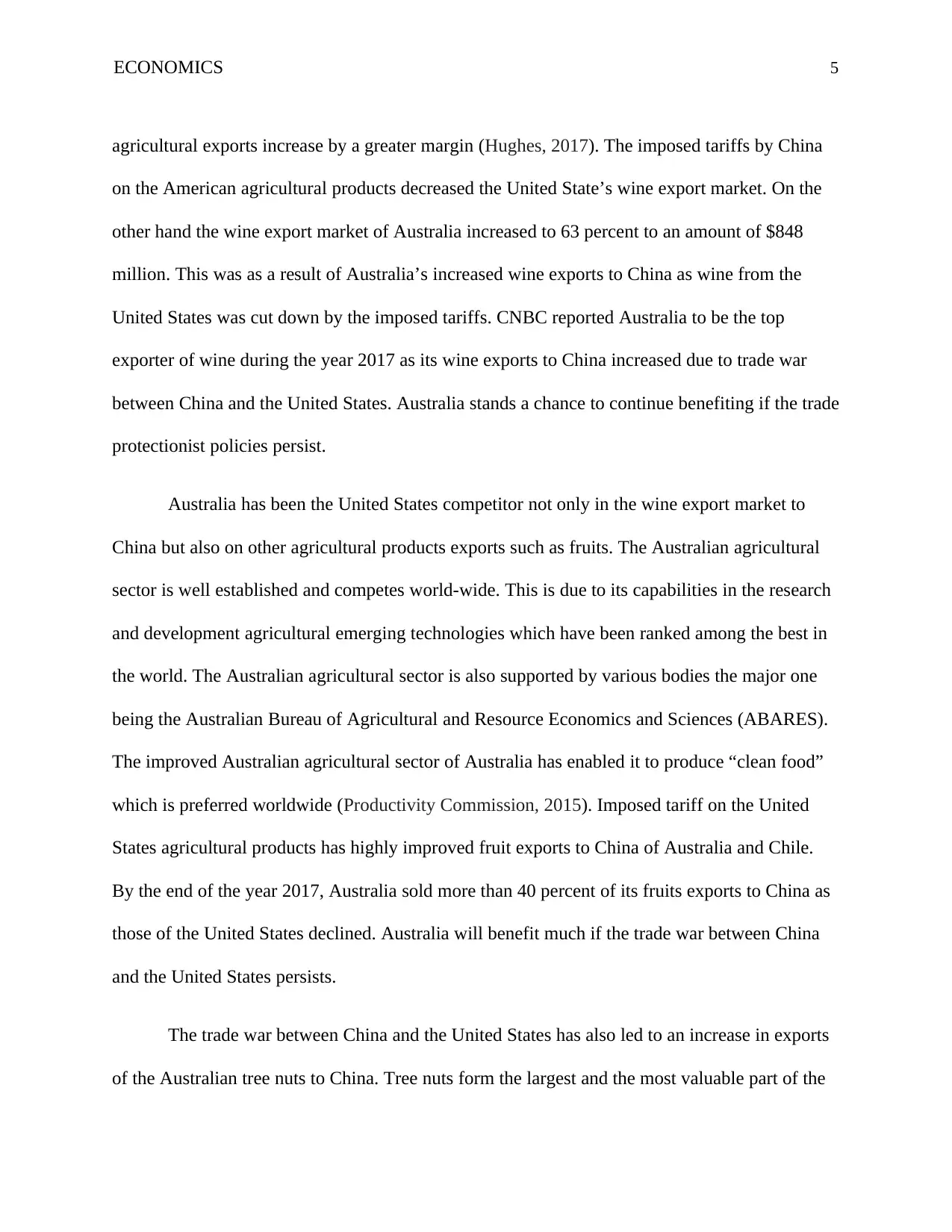
ECONOMICS 5
agricultural exports increase by a greater margin (Hughes, 2017). The imposed tariffs by China
on the American agricultural products decreased the United State’s wine export market. On the
other hand the wine export market of Australia increased to 63 percent to an amount of $848
million. This was as a result of Australia’s increased wine exports to China as wine from the
United States was cut down by the imposed tariffs. CNBC reported Australia to be the top
exporter of wine during the year 2017 as its wine exports to China increased due to trade war
between China and the United States. Australia stands a chance to continue benefiting if the trade
protectionist policies persist.
Australia has been the United States competitor not only in the wine export market to
China but also on other agricultural products exports such as fruits. The Australian agricultural
sector is well established and competes world-wide. This is due to its capabilities in the research
and development agricultural emerging technologies which have been ranked among the best in
the world. The Australian agricultural sector is also supported by various bodies the major one
being the Australian Bureau of Agricultural and Resource Economics and Sciences (ABARES).
The improved Australian agricultural sector of Australia has enabled it to produce “clean food”
which is preferred worldwide (Productivity Commission, 2015). Imposed tariff on the United
States agricultural products has highly improved fruit exports to China of Australia and Chile.
By the end of the year 2017, Australia sold more than 40 percent of its fruits exports to China as
those of the United States declined. Australia will benefit much if the trade war between China
and the United States persists.
The trade war between China and the United States has also led to an increase in exports
of the Australian tree nuts to China. Tree nuts form the largest and the most valuable part of the
agricultural exports increase by a greater margin (Hughes, 2017). The imposed tariffs by China
on the American agricultural products decreased the United State’s wine export market. On the
other hand the wine export market of Australia increased to 63 percent to an amount of $848
million. This was as a result of Australia’s increased wine exports to China as wine from the
United States was cut down by the imposed tariffs. CNBC reported Australia to be the top
exporter of wine during the year 2017 as its wine exports to China increased due to trade war
between China and the United States. Australia stands a chance to continue benefiting if the trade
protectionist policies persist.
Australia has been the United States competitor not only in the wine export market to
China but also on other agricultural products exports such as fruits. The Australian agricultural
sector is well established and competes world-wide. This is due to its capabilities in the research
and development agricultural emerging technologies which have been ranked among the best in
the world. The Australian agricultural sector is also supported by various bodies the major one
being the Australian Bureau of Agricultural and Resource Economics and Sciences (ABARES).
The improved Australian agricultural sector of Australia has enabled it to produce “clean food”
which is preferred worldwide (Productivity Commission, 2015). Imposed tariff on the United
States agricultural products has highly improved fruit exports to China of Australia and Chile.
By the end of the year 2017, Australia sold more than 40 percent of its fruits exports to China as
those of the United States declined. Australia will benefit much if the trade war between China
and the United States persists.
The trade war between China and the United States has also led to an increase in exports
of the Australian tree nuts to China. Tree nuts form the largest and the most valuable part of the
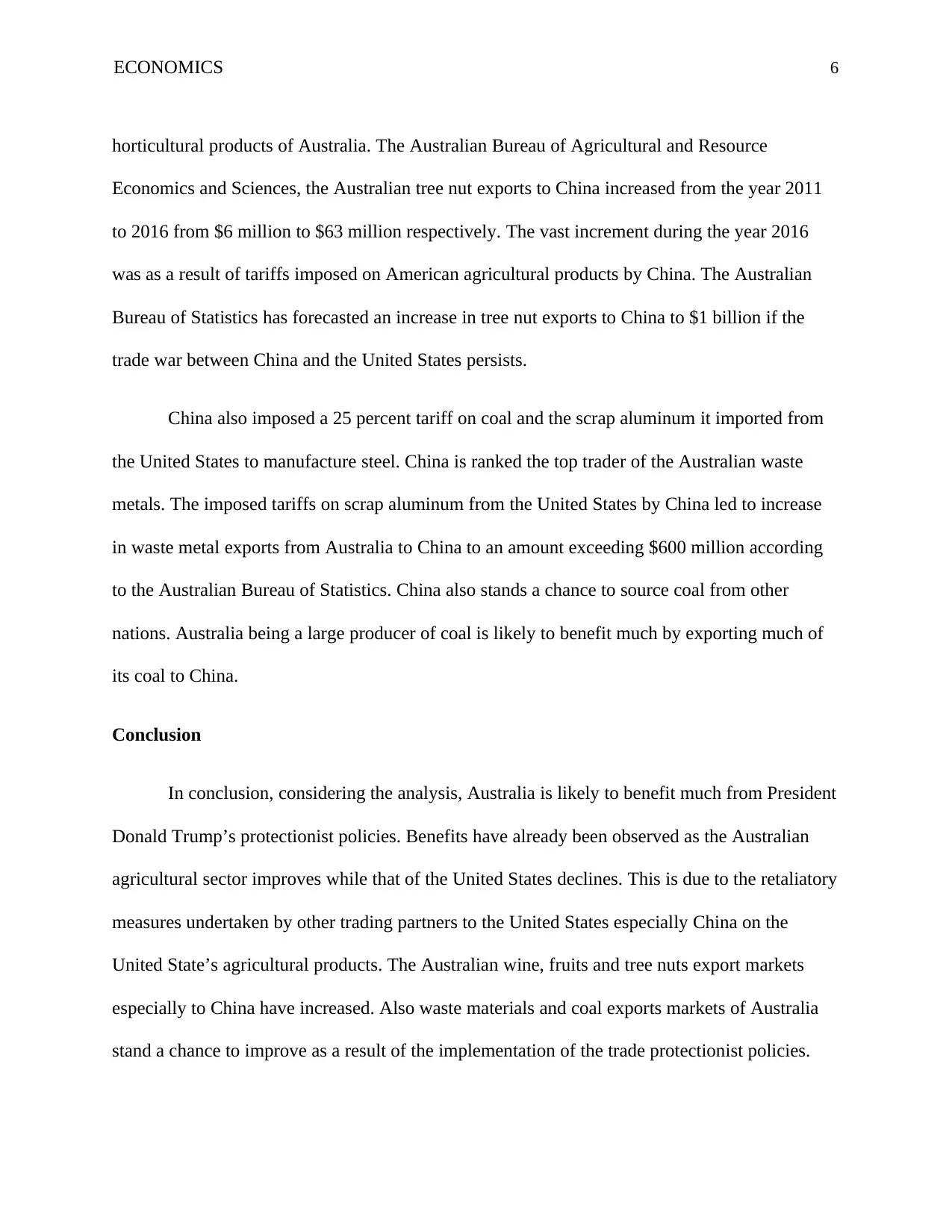
ECONOMICS 6
horticultural products of Australia. The Australian Bureau of Agricultural and Resource
Economics and Sciences, the Australian tree nut exports to China increased from the year 2011
to 2016 from $6 million to $63 million respectively. The vast increment during the year 2016
was as a result of tariffs imposed on American agricultural products by China. The Australian
Bureau of Statistics has forecasted an increase in tree nut exports to China to $1 billion if the
trade war between China and the United States persists.
China also imposed a 25 percent tariff on coal and the scrap aluminum it imported from
the United States to manufacture steel. China is ranked the top trader of the Australian waste
metals. The imposed tariffs on scrap aluminum from the United States by China led to increase
in waste metal exports from Australia to China to an amount exceeding $600 million according
to the Australian Bureau of Statistics. China also stands a chance to source coal from other
nations. Australia being a large producer of coal is likely to benefit much by exporting much of
its coal to China.
Conclusion
In conclusion, considering the analysis, Australia is likely to benefit much from President
Donald Trump’s protectionist policies. Benefits have already been observed as the Australian
agricultural sector improves while that of the United States declines. This is due to the retaliatory
measures undertaken by other trading partners to the United States especially China on the
United State’s agricultural products. The Australian wine, fruits and tree nuts export markets
especially to China have increased. Also waste materials and coal exports markets of Australia
stand a chance to improve as a result of the implementation of the trade protectionist policies.
horticultural products of Australia. The Australian Bureau of Agricultural and Resource
Economics and Sciences, the Australian tree nut exports to China increased from the year 2011
to 2016 from $6 million to $63 million respectively. The vast increment during the year 2016
was as a result of tariffs imposed on American agricultural products by China. The Australian
Bureau of Statistics has forecasted an increase in tree nut exports to China to $1 billion if the
trade war between China and the United States persists.
China also imposed a 25 percent tariff on coal and the scrap aluminum it imported from
the United States to manufacture steel. China is ranked the top trader of the Australian waste
metals. The imposed tariffs on scrap aluminum from the United States by China led to increase
in waste metal exports from Australia to China to an amount exceeding $600 million according
to the Australian Bureau of Statistics. China also stands a chance to source coal from other
nations. Australia being a large producer of coal is likely to benefit much by exporting much of
its coal to China.
Conclusion
In conclusion, considering the analysis, Australia is likely to benefit much from President
Donald Trump’s protectionist policies. Benefits have already been observed as the Australian
agricultural sector improves while that of the United States declines. This is due to the retaliatory
measures undertaken by other trading partners to the United States especially China on the
United State’s agricultural products. The Australian wine, fruits and tree nuts export markets
especially to China have increased. Also waste materials and coal exports markets of Australia
stand a chance to improve as a result of the implementation of the trade protectionist policies.
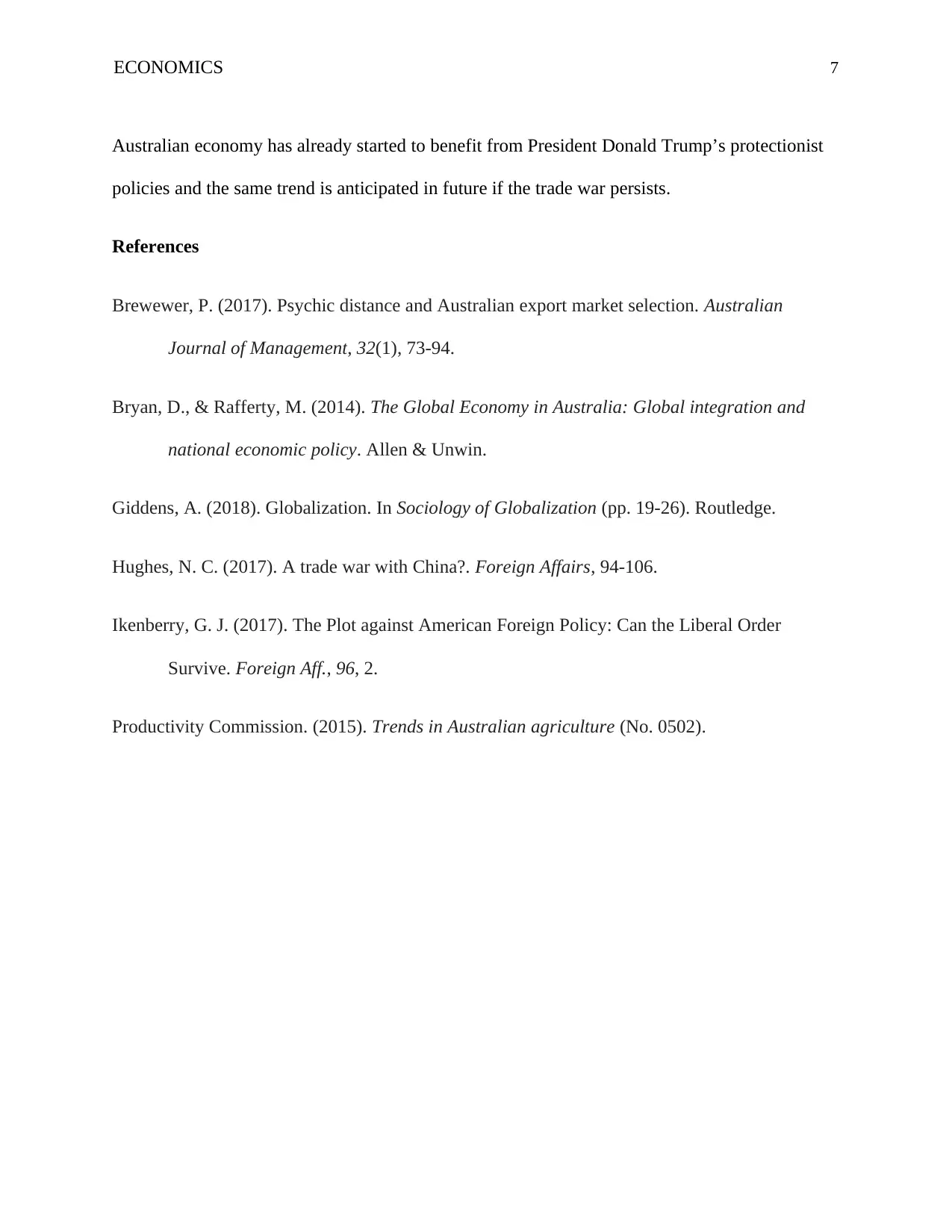
ECONOMICS 7
Australian economy has already started to benefit from President Donald Trump’s protectionist
policies and the same trend is anticipated in future if the trade war persists.
References
Brewewer, P. (2017). Psychic distance and Australian export market selection. Australian
Journal of Management, 32(1), 73-94.
Bryan, D., & Rafferty, M. (2014). The Global Economy in Australia: Global integration and
national economic policy. Allen & Unwin.
Giddens, A. (2018). Globalization. In Sociology of Globalization (pp. 19-26). Routledge.
Hughes, N. C. (2017). A trade war with China?. Foreign Affairs, 94-106.
Ikenberry, G. J. (2017). The Plot against American Foreign Policy: Can the Liberal Order
Survive. Foreign Aff., 96, 2.
Productivity Commission. (2015). Trends in Australian agriculture (No. 0502).
Australian economy has already started to benefit from President Donald Trump’s protectionist
policies and the same trend is anticipated in future if the trade war persists.
References
Brewewer, P. (2017). Psychic distance and Australian export market selection. Australian
Journal of Management, 32(1), 73-94.
Bryan, D., & Rafferty, M. (2014). The Global Economy in Australia: Global integration and
national economic policy. Allen & Unwin.
Giddens, A. (2018). Globalization. In Sociology of Globalization (pp. 19-26). Routledge.
Hughes, N. C. (2017). A trade war with China?. Foreign Affairs, 94-106.
Ikenberry, G. J. (2017). The Plot against American Foreign Policy: Can the Liberal Order
Survive. Foreign Aff., 96, 2.
Productivity Commission. (2015). Trends in Australian agriculture (No. 0502).
1 out of 7
Related Documents
Your All-in-One AI-Powered Toolkit for Academic Success.
+13062052269
info@desklib.com
Available 24*7 on WhatsApp / Email
![[object Object]](/_next/static/media/star-bottom.7253800d.svg)
Unlock your academic potential
© 2024 | Zucol Services PVT LTD | All rights reserved.





